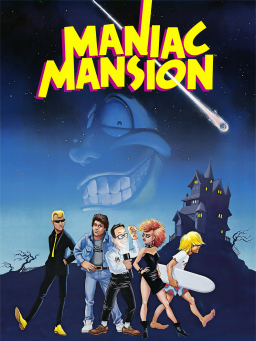
Maniac Mansion is a 1987 graphic adventure video game developed and published by Lucasfilm Games. It follows teenage protagonist Dave Miller as he attempts to rescue his girlfriend Sandy Pantz from a mad scientist, whose mind has been enslaved by a sentient meteor. The player uses a point-and-click interface to guide Dave and two of his six playable friends through the scientist's mansion while solving puzzles and avoiding dangers. Gameplay is non-linear, and the game must be completed in different ways based on the player's choice of characters. Initially released for the Commodore 64 and Apple II, Maniac Mansion was Lucasfilm Games' first self-published product.

Simon the Sorcerer is a 1993 point-and-click adventure game developed and published by Adventure Soft, for Amiga and MS-DOS. The game's story focuses on a boy named Simon who is transported into a parallel universe of magic and monsters, where he embarks on a mission to become a wizard and rescue another from an evil sorcerer. The game's setting was inspired by the novels of the Discworld series, and incorporates parodies on fantasy novels and fairy tales, such as The Lord of the Rings and Jack and the Beanstalk. The lead character's design was inspired by that of the fictional British television character Blackadder, with the character voiced by Chris Barrie in the CD re-release.

Populous is a video game developed by Bullfrog Productions and published by Electronic Arts, released originally for the Amiga in 1989, and is regarded by many as the first god game. With over four million copies sold, Populous is one of the best-selling PC games of all time.
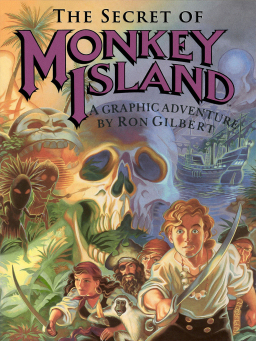
The Secret of Monkey Island is a 1990 point-and-click graphic adventure game developed and published by Lucasfilm Games. It takes place in a fictional version of the Caribbean during the age of piracy. The player assumes the role of Guybrush Threepwood, a young man who dreams of becoming a pirate, and explores fictional islands while solving puzzles.
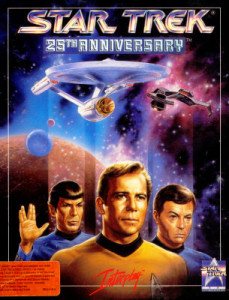
Star Trek: 25th Anniversary is an adventure video game developed and published by Interplay Productions in 1992, based on the Star Trek universe. The game chronicles various missions of James T. Kirk and his crew of the USS Enterprise. Its 1993 sequel, Star Trek: Judgment Rites, continues and concludes this two-game series.

Shadow of the Beast is a platform game developed by Reflections and published by Psygnosis in 1989. The original version was released for the Amiga, and was later ported to several other systems. The game was known for its graphics, with many colours on screen and up to twelve levels of parallax scrolling backdrops, and for its atmospheric score composed by David Whittaker that used high-quality instrument samples.
Magnetic Scrolls was a British video game developer active between 1984 and 1990. A pioneer of audiovisually elaborate text adventure games, it was one of the largest and most acclaimed interactive fiction developers of the 1980s, and one of the "Big Two" with Infocom according to some.
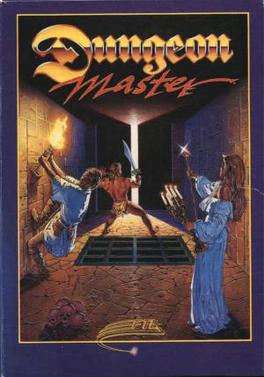
Dungeon Master is a role-playing video game featuring a pseudo-3D first-person perspective. It was developed and published by FTL Games for the Atari ST in 1987, almost identical Amiga and PC (DOS) ports following in 1988 and 1992.

Ultima VI: The False Prophet, released by Origin Systems in 1990, is the sixth part in the role-playing video game series of Ultima. It is the third and final game in the "Age of Enlightenment" trilogy. Ultima VI sees the player return to Britannia, at war with a race of gargoyles from another land, struggling to stop a prophecy from ending their race. The player must help defend Britannia against these gargoyles, and ultimately discover the secrets about both lands and its peoples.

The Pawn is an interactive fiction game for the Sinclair QL written by Rob Steggles of Magnetic Scrolls and published by Sinclair Research in 1985. In 1986, graphics were added and the game was released for additional home computers by Rainbird.

King's Quest VI: Heir Today, Gone Tomorrow is a point-and-click adventure game, first released in 1992 as the sixth installment in the King's Quest series produced by Sierra On-Line. Written by Roberta Williams and Jane Jensen, King's Quest VI is widely recognized as the high point in the series for its landmark 3D graphic introduction movie and professional voice acting. King's Quest VI was programmed in Sierra's Creative Interpreter and was the last King's Quest game to be released on floppy disk. A CD-ROM version of the game was released in 1993, including more character voices, a slightly different opening movie and more detailed artwork and animation.

Rise of the Dragon, released in 1990 by Dynamix, marks the company's venture into the cyberpunk genre, distinct from its usual portfolio of action and flight simulators. This graphic adventure game is set in a future dystopian version of Los Angeles, circa 2053, and follows the story of detective William 'Blade' Hunter as he investigates the death of the mayor's daughter, linked to a dangerous new drug, MTZ. The gameplay combines detective work, strategy, and action. Players must solve puzzles that influence the storyline, interact with characters who remember past choices, and tackle action sequences. If players fail these sequences multiple times, the game may offer to automatically complete them.

The Faery Tale Adventure is a 1987 action role-playing video game designed by David Joiner and published by MicroIllusions for the Amiga, and later ported to the Commodore 64, MS-DOS, and Sega Genesis. The MS-DOS version is titled The Faery Tale Adventure: Book I. Microillusions also released a "Book 1" version for the Amiga which was going to be the start of a series of games, according to Talin, but bankruptcy prevented it. The initial version was produced for the Amiga 1000 and featured the largest game world to that date. A sequel, Faery Tale Adventure II: Halls of the Dead, was released in 1997.
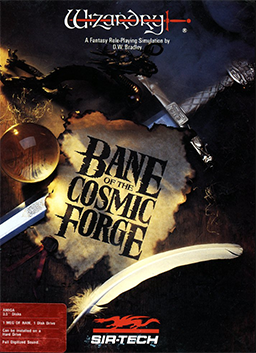
Wizardry VI: Bane of the Cosmic Forge is the 6th title in the Wizardry series of role-playing video games. It was the first in the trilogy surrounding the Dark Savant, which was followed by Wizardry VII: Crusaders of the Dark Savant and Wizardry 8. It was developed by Sir-Tech Software, Inc. and was released on the Amiga and DOS platforms in 1990 by the same company, and for the Super Famicom in Japan in 1995 by ASCII.

Police Quest III: The Kindred is a 1991 police procedural point-and-click adventure video game developed and published by Jim Walls and Sierra On-Line. It is the third installment in the Police Quest series. The game finishes the story of police officer Sonny Bonds, who seeks revenge after his wife is attacked by an unknown assailant.

Legend of Faerghail is a 1990 role-playing video game, developed by Electronic Design Hannover and published by reLINE Software for the Amiga, Atari ST and MS-DOS.

Corruption is an interactive fiction game by Magnetic Scrolls released in 1988. In this game, a successful stockbroker suddenly finds himself embroiled in a world of crime and danger.

The Great Battles of Alexander is a 1997 turn-based computer wargame developed by Erudite Software and published by Interactive Magic. Adapted from the GMT Games physical wargame of the same name, it depicts 10 of Alexander the Great's key conflicts, and simulates the interplay between Ancient Macedonian battle tactics and its rival military doctrines. Gameplay occurs at the tactical level: players direct predetermined armies on discrete battlefields, in a manner that one commentator compared to chess.

Links: The Challenge of Golf is a golf video game developed by Access Software. It was published for MS-DOS in 1990, followed by the Amiga in 1992. A Sega CD version, developed by Papyrus Design Group, was released in 1994. It is the first game in the Links series, and was followed by Links 386 Pro (1992). A Microsoft Windows version, titled Microsoft Golf, was released in 1992 as the first game in the Microsoft Golf series.
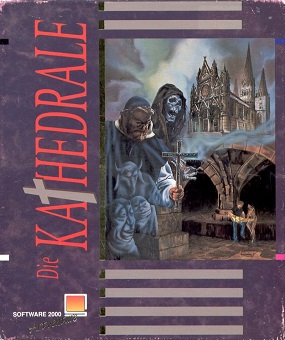
Die Kathedrale is a 1991 German text adventure game developed by Weltenschmiede and published by Software 2000 for the Amiga and DOS. Die Kathedrale is part of a text adventure trilogy; it is preceded by Das Stundenglas (1990) and succeeded by Hexuma (1992). The trilogy lacks an overarching plot, and in each entry the setting, role of the protagonist, and goal differ between each game. Games in the trilogy do not require knowledge of the other entries and may be played as standalone games.


















